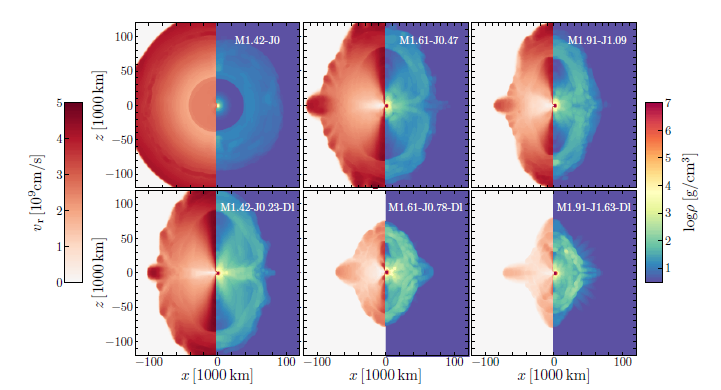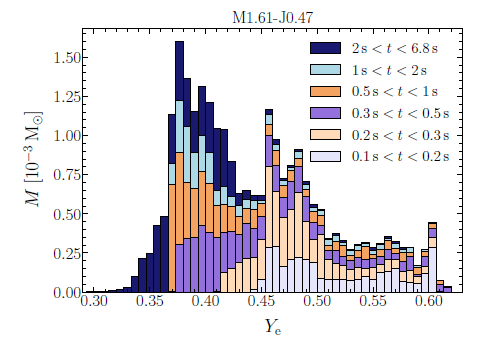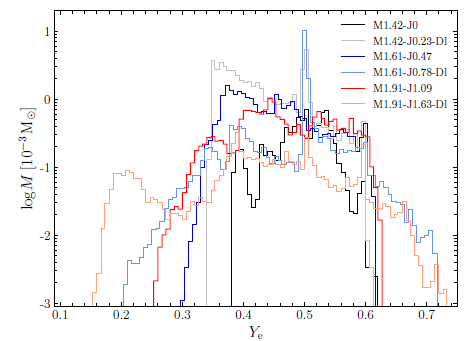ASTROPHYSICS
Neutron Star Formation from Collapsing White Dwarfs
Principal Investigator:
Prof. Dr. Hans-Thomas Janka
Affiliation:
Max Planck Gesellschaft Institut, Max-Planck-Institut für Astrophysik, Garching, Germany
Local Project ID:
pn49sa
HPC Platform used:
SuperMUC-NG at LRZ
Date published:
Introduction
Neutron stars are the most compact objects in the Universe with typically 1.5 times the mass of our Sun compressed into a sphere of just about 25 km in diameter, implying central densities higher than those in atomic nuclei. Most neutron stars are formed as remnants of massive stars when the degenerate core of these stars becomes gravitationally unstable and collapses, while most of the stellar matter is ejected in a violent supernova explosion with velocities up to 10,000 km/s. Two such neutron stars in a binary system can collide in a violent merger event after having approached each other on a spiral orbit over hundred of millions to billions of years, driven by the continuous emission of gravitational waves.
Such signals from the late inspiral phase shortly before the final merger have been captured already by the laser interferometer detectors of LIGO and Virgo. The most prominent case is the first-ever detected event of August 17, 2017, termed GW170817, which was accompanied by a short gamma-ray burst, GRB170817A, and an astronomical transient, AT2017gfo. This so-called kilonova emitted ultraviolet, optical, and infrared light over a period of about 10 days, powered by the energy released in the radioactive decay of very neutron-rich, trans-iron nuclei formed in the so-called rapid neutron-capture process. Binary neutron star mergers are thus the first observationally confirmed cosmic sources of super-heavy chemical elements including silver, cadmium, and caesium. According to numerical models also ultra-heavy species such as gold, platinum, thorium, and uranium could be produced, but it is still unclear whether these chemical elements were indeed made by GW170817.
Besides being the remnants of massive stars, neutron stars might alternatively form by the gravitational collapse of white dwarfs. White dwarfs are degenerate remnants of stars with masses lower than those collapsing to neutron stars. Living in close binary systems, they can accrete matter from a normal companion star or they can collide with a second white dwarf after a long inspiral evolution due to gravitational-wave emission. Both scenarios are expected to lead to explosions called thermonuclear (“Type Ia”) supernovae. However, under special circumstances also an accretion-induced collapse (AIC) or a merger-induced collapse (MIC) of the white dwarfs to neutron stars might result. Such events have been proposed decades ago, but they have not been studied in much detail and have not been discovered so far. The emerging neutron stars may have masses, recoil velocities, and spins different from neutron stars born in collapsing massive stars. Moreover, mass ejection by AIC and MIC events could contribute to the enrichment of galaxies with heavy chemical elements, and predicting the ejecta properties is crucial for identifying these collapse events in observations. Our project aimed to explore these questions by developing a first set of long-term neutrino-hydrodynamical simulations of collapsing white dwarfs for a representative set of initial conditions.
Methods and Results
The PI’s team performed two-dimensional (axi-symmetric; 2D) simulations with the Alcar code, which integrates the Euler equations for the conservation of mass, momentum, energy, and electron-lepton number of the stellar plasma, coupled with an energy and velocity dependent transport solver for neutrinos and antineutrinos of all three lepton flavors (electron, muon, and tau neutrinos). The Newtonian hydrodynamics equations include source terms for gravity (with general relativistic corrections) as well as for the exchange of electron-lepton number, momentum, and energy between neutrinos and the stellar plasma. The neutrino source terms account for all relevant interactions (beta processes, pair-neutrino creation and annihilation, and scattering reactions). The transport treatment is based on a two-moment scheme for the coupled neutrino momentum and energy equations with an analytic closure relation for the neutrino pressure tensor (“M1 scheme”). The partial differential equations are discretized by a conservative finite-volume method (Godunov scheme) with higher-order accuracy in space and time and using an approximate Riemann solver. The numerical integration is performed by explicit time stepping and implicit treatment of most source terms. The pressure of the stellar plasma (composed of atomic nuclei, nucleons, electrons, positrons, photons) as a function of the thermodynamic variables is described by a modern equation of state ranging from sun-like conditions to the super-nuclear densities and several 100 billion Kelvin characteristic of newly formed neutron stars.
The simulations were initiated from six white dwarf models in rotational equilibrium for different masses, central densities, rotation rates, and rotation profiles, supported by degenerate-electron pressure and representing various conditions that may result from accretion and merger evolution [1]. High spatial resolution (1.875 degrees in lateral angle and up to 1600 radial zones) was essential to resolve the steep density gradient near the surface of the forming and contracting neutron stars. With an allocated 18.31 million core-h and 960 cores used on SuperMUC per run, nearly 9 seconds of evolution could be covered for all models.
These simulations show that rotation is a crucial ingredient that determines the properties of the neutron stars and ejecta. Ejecta masses and energies are tightly correlated and can vary from about 0.006 to over 0.05 solar masses and from 1049 erg to 3x1050 erg, respectively. Rapidly spinning white dwarfs form neutron stars enveloped by thick equatorial belts of centrifugally supported matter that may strip off more mass when evolving by angular momentum loss over secular time scales. The mass ejection occurs predominantly to the poles such that the expanding clouds of matter display prominent bipolar structures, bounded by shock fronts [2]. The spatial extension of the spherical or prolate shocks at a given time (3 seconds after the neutron star started to form in Figure 1) scales directly with the ejecta energy.
Interestingly, there are distinctive differences in the dynamics and composition of ejecta from non-rotating and rotating collapsing white dwarfs [3]. In the nearly spherical ejecta of non-rotating models, moderately neutron-rich matter is expelled with highest velocities first, whereas later ejecta evolve to increasingly proton-rich conditions, analogous to what was found when non-rotating cores of stars near the low-mass end of core-collapse progenitors form neutron stars in so-called electron-capture-like supernovae. Rotation reverses the picture such that the ejecta are increasingly more neutron-rich the later they get expelled (Figure 2). In the most rapidly spinning cases the earliest ejecta are proton-rich. These differences can be explained by the dynamics of the expanding matter and the impact of neutrino emission and absorption in the outflows. Proton-rich and neutron-rich conditions lead to characteristic differences in the chemical elements that are assembled when the initially hot matter cools by expansion and neutrons and protons recombine to alpha particles and heavy nuclei. A rapid neutron-capture process can occur for neutron excess, possibly even forming the heaviest chemical elements from gold to uranium in the cases of the fastest spinning white dwarfs, where some ejecta are extremely neutron-rich (Figure 3).
Ongoing Research / Outlook
The simulations carried out in this project are the first of their kind in following the formation process of spinning neutron stars created by white-dwarf collapse over several seconds. Besides the ejecta conditions, the models also predict the associated neutrino signals and have been evaluated for their gravitational-wave emission [4]. Moreover, our hydrodynamic results will be analyzed for the nucleosynthesis of chemical elements by post-processing them with nuclear reaction networks. Ultimately, this will facilitate detailed predictions of characteristic properties of observable electromagnetic emission connected with the mass ejection during AIC and MIC events. This will guide astronomical searches for such kilonova-like transients.
In a next step of improving the theoretical models, more realistic initial configurations, once available, will have to replace our constructed white dwarfs. On a longer perspective, 3D simulations are needed because triaxial instabilities during the collapse of rapidly and differentially rotating white dwarfs may lead to interesting phenomena, e.g., gravitational-wave features, enhanced mass loss, changes of the ejecta geometry, though the basic picture emerging from our reference models is unlikely to change. Carrying 3D simulations over similarly long time scales with sufficient resolution will be challenging. This holds, in particular, for 3D simulations including magnetic fields, which will unavoidably be amplified to dynamically relevant strengths in the differentially spinning, new-born neutron stars. The high spatial resolution needed to follow magnetohydrodynamic instabilities on short length scales will pose even greater demands on computational resources. Our models therefore define only the starting point of much more work to be done in the future.
References and Links
[1] J.C. Ehring, “Accretion-Induced Collapse of White Dwarfs”, Master Thesis, LMU (2019).
[2] E. Batziou, “Neutron Star Formation in Accretion-Induced Collapse of White Dwarfs”, PhD Thesis, TUM (2023).
[3] E. Batziou, R. Glas, H.-Th. Janka, J. Ehring, E. Abdikamalov, & O. Just, ApJ, 984 (2025) 197.
[4] J. Cai, “Gravitational Waves from Long-term Axisymmetric Simulations of Accretion-induced Collapse of White Dwarfs”, Master Thesis, TUM (2025).

Figure 1: Snapshots of expanding ejecta in our six simulations at 3 seconds after the neutron star formation by white-dwarf collapse. The left half-panels display the radial velocity, the right half-panels the logarithm of the matter density. The upper left model is non-rotating, the models in the right column rotate most rapidly. The masses of the initial white dwarfs are 1.42, 1.61, and 1.91 solar masses (from left to right).

Figure 2: Ejecta mass versus “electron fraction”, which is the ratio of electron (or proton) number density to the total number density of protons plus neutrons. In this moderately fast rotating case of a collapsing white dwarf with 1.61 solar masses, the early ejecta are moderately neutron-rich (Ye ~ 0.45) to significantly proton-rich (Ye ~ 0.6), and increasingly neutron-rich (Ye < 0.5) ejecta follow as time progresses.

Figure 3: Ejecta mass distributions versus electron fraction for our six simulations. Collapsing white dwarfs with fast rotation eject highly neutron-rich matter (Ye much below 0.5). Lanthanides will form for Ye < 0.3, actinides for Ye < 0.25.